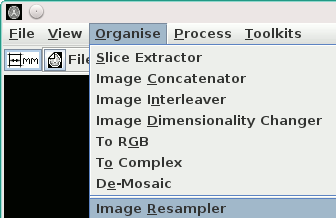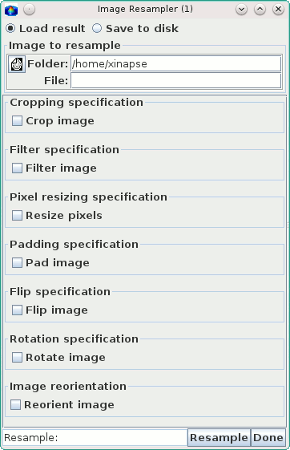Image Resampler from
the Organise menu:
 of the main display
frame. This brings up the Image Resampler tool:
of the main display
frame. This brings up the Image Resampler tool:
Jim can resample an existing image to have different numbers of slices, rows, columns and frames (for multi-frame images). The Resampler can crop images, resize image pixels, pad images to a larger size, reorient images to a different imaging plane and perform filtering operations.
When resizing pixels, if the number of samples that you request is less than the original, Jim will average pixel values to sub-sample the image. If the number of samples that you request is greater than the original, Jim will interpolate pixel values to create an image with greater (digital) resolution.
When resizing pixels, you can either specify the new pixel size, or the number of samples that you require. Jim will then work out the best resampling strategy.
To resample or filter an existing image, select Image Resampler from
the Organise menu:
 of the main display
frame. This brings up the Image Resampler tool:
of the main display
frame. This brings up the Image Resampler tool:


First select the Input Image by clicking on the  icon,
or by typing in the folder (directory) and file name of the image, or by pressing the right mouse
button and selecting from the menu of recently-used images.
icon,
or by typing in the folder (directory) and file name of the image, or by pressing the right mouse
button and selecting from the menu of recently-used images.

To crop an image, click the  check
box. Enter the start and end values for the row
numbers, column numbers, slice numbers and frames numbers (if
applicable) for the cropped image. You can set the default
values (the full range as the original image) by
clicking the
check
box. Enter the start and end values for the row
numbers, column numbers, slice numbers and frames numbers (if
applicable) for the cropped image. You can set the default
values (the full range as the original image) by
clicking the  button. (You must set an input image before the Set
Defaults button will bring up the defaults.)
button. (You must set an input image before the Set
Defaults button will bring up the defaults.)
Note: the valid range of values goes from 1 to the number
of samples in each dimension. Entering a value outside this range
will cause an error message to be displayed.
To filter an image, click the
You can set the degree of noise suppression using the slider, either as:
Calculated colour values should lie between 0.0 and 1.0, and are scaled by 255 in the output
image to give colour gun values between 0 and 255. Values that result from application of
the three formulas that lie outside this range are clipped. This image filter is only
applicable to colour images.
There are two ways to specify how you want the image pixels to be resized:
When you have set up the resampling scheme, click on the
To pad an image, click the
Note: the image is padded as evenly as possible around the edges. For example
suppose the image to be padded has 256 columns, and you specify
that the padded image will have 261 columns. Three columns are
added to the left hand side of the image, and two to the right to
make up the difference in the number of columns.
Note: to rotate an image by arbitrary angles, use the Multi-Planar
Reconstruction tool.
To rotate an image, click the
To reorient an image, click the
Jim may be able to determine the orientation of
the original image (which it needs in order to perform the
reorientation correctly). If it cannot, you will see an error
message; in this case, tell Jim the original orientation by
selecting the Filtering
You can apply one of several filtering operations to change the nature of the intensities of
the image.
 check
box, and select the tab for the type of filter you want to apply. You can choose:
check
box, and select the tab for the type of filter you want to apply. You can choose:






Using the percentage of the image intensity range will give more
consistent results when the image intensity range varies across images.


Resizing pixels
To resize the pixels of an image, click the  check
box.
check
box.

 button. (You must set an input image before the Set Defaults button
will bring up the defaults.)
button. (You must set an input image before the Set Defaults button
will bring up the defaults.)
![]()
 button. (You must set an input image before the Set Defaults button
will bring up the defaults.)
button. (You must set an input image before the Set Defaults button
will bring up the defaults.)
 button to do the
resampling. If you have chosen to save the result to disk, then a
File Chooser will pop up, prompting
you to choose a file name for the new (re-sampled) image; otherwise, the result
will be loaded into Jim.
button to do the
resampling. If you have chosen to save the result to disk, then a
File Chooser will pop up, prompting
you to choose a file name for the new (re-sampled) image; otherwise, the result
will be loaded into Jim.
Type of Interpolation
If the number of samples you specify is greater than the original
in any dimension, or if the pixel size is smaller than the original, then the image
must be interpolated to obtain the new intensity values.

Type of Sub-sampling
If the number of samples you specify is fewer than the original
in any dimension, or if the pixel size is larger than the original, then the image
must be sub-sampled to obtain the new intensity values.

Padding
Padding involves putting extra columns, rows, slices and frames in
an image, to create an image that has a greater number of pixels
than it had originally.
 check
box. Enter the numbers of columns, rows, slices and frames (if
applicable) for the padded image. Each value you enter should be
at least as large as the number of samples in the original image
(or, if you have performed cropping or resampling, in the result
of these operations). You can set the default
values (the same range as in the original image) by clicking the
check
box. Enter the numbers of columns, rows, slices and frames (if
applicable) for the padded image. Each value you enter should be
at least as large as the number of samples in the original image
(or, if you have performed cropping or resampling, in the result
of these operations). You can set the default
values (the same range as in the original image) by clicking the  button.
button.
Flipping
Use this to flip an image about one or more axes. Select the required flip(s) by clicking on the
appropriate buttons:
 to left-right flip the image about a vertical axis as
seen on screen.
to left-right flip the image about a vertical axis as
seen on screen. to flip the image from top-to-bottom about a horizontal
axis as seen on screen.
to flip the image from top-to-bottom about a horizontal
axis as seen on screen. to reverse the slice order.
to reverse the slice order.Rotating
You can rotate an image in steps of 90 degrees, while keeping the same image planes.
 check
box. Select the required rotation by clicking on the
appropriate button:
check
box. Select the required rotation by clicking on the
appropriate button:
 to rotate the image by 90 degrees counter-clockwise.
to rotate the image by 90 degrees counter-clockwise. to rotate the image by 90 degrees clockwise.
to rotate the image by 90 degrees clockwise. to rotate the image by 180 degrees.
to rotate the image by 180 degrees.Reorienting
Reorienting involves changing the imaging plane (for example, from
axial to coronal).
 check
box. Select the orientation required by clicking on the
appropriate button in the
check
box. Select the orientation required by clicking on the
appropriate button in the New orientation panel.

 check
box and clicking on the appropriate button in the
check
box and clicking on the appropriate button in the Current
orientation panel.

 check-box to tell Jim
that your image slice order does not follow the standard
radiological convention.
check-box to tell Jim
that your image slice order does not follow the standard
radiological convention.